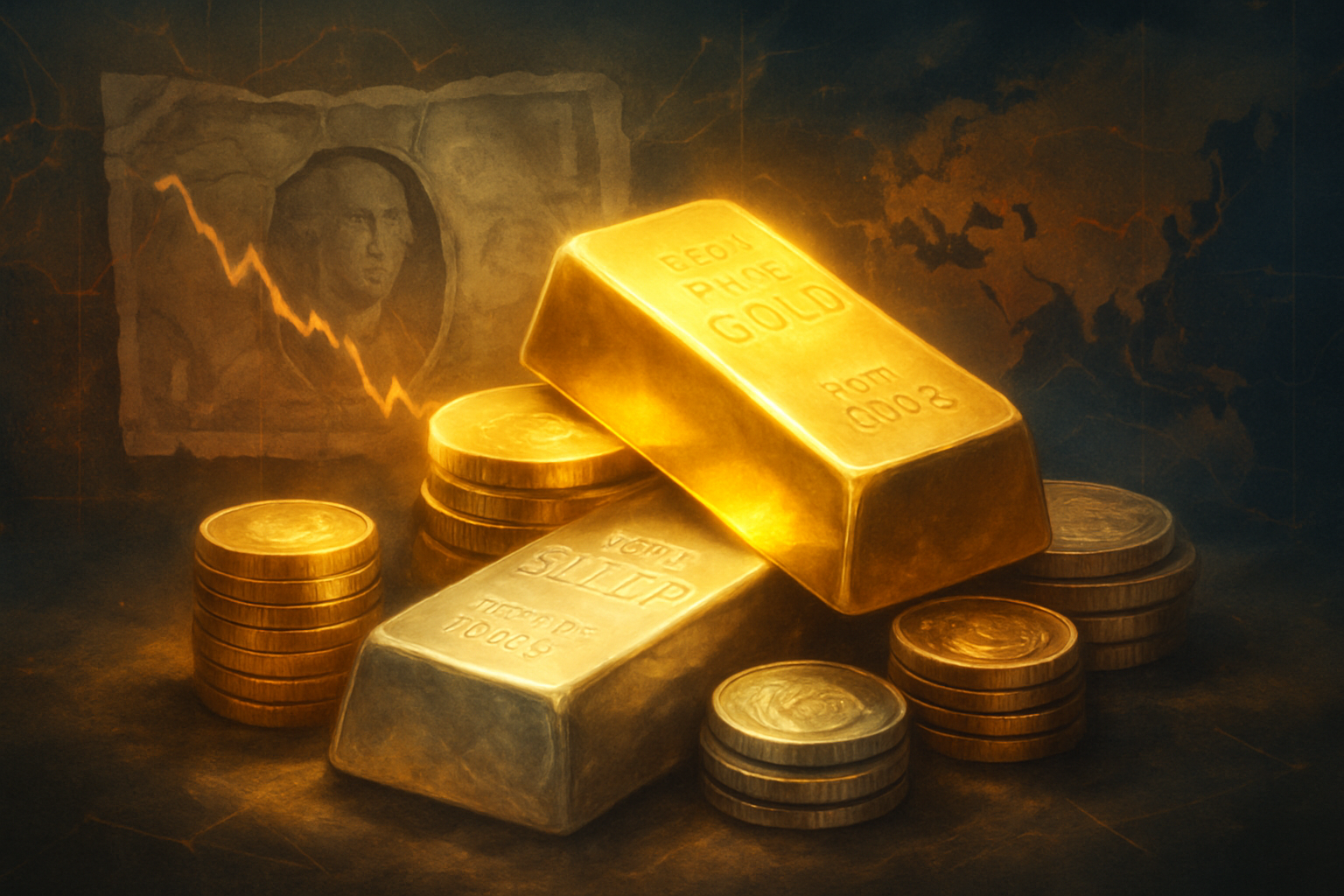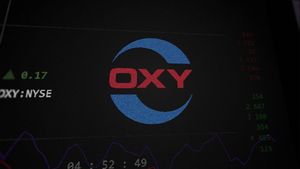
In an era defined by geopolitical turbulence, persistent inflation, and a softening U.S. dollar, gold and silver have emerged as undeniable safe-haven assets, experiencing an unprecedented surge in value. As of October 2025, gold prices are nearing an astonishing $3,900 per ounce, while silver has climbed to 14-year highs, approaching $48 per ounce, outperforming gold in percentage terms year-to-date. This dramatic ascent is not merely a fleeting market anomaly but, according to a growing chorus of experts including Rich Dad Poor Dad author Robert Kiyosaki, signals a profound shift in investor sentiment and a potential re-evaluation of global financial anchors.
The rally in precious metals is fueled by a complex interplay of factors, including escalating global conflicts, domestic political instability – highlighted by a recent U.S. government shutdown commencing October 1, 2025 – and the persistent erosion of purchasing power due to inflation. Simultaneously, the U.S. dollar's role as the undisputed global reserve currency is facing its most significant challenge in decades, with its value depreciating over 11% in 2025, the sharpest annual decline since the early 1970s. This confluence of events has ignited a robust debate among financial strategists and economists about the staying power of this precious metals bull run and the future of the international financial order.
The Unprecedented Ascent of Precious Metals: A Detailed Look
The remarkable bull run in gold and silver in 2025 is a direct response to deepening investor concerns over geopolitical and economic instability. Gold, traditionally seen as the ultimate inflation hedge, has benefited from inflation persistently hovering above the Federal Reserve's 2% target, prompting investors to safeguard their wealth against currency devaluation. For silver, its dual role as a monetary metal and a critical industrial commodity has amplified its appeal. Significant demand from rapidly expanding sectors such as solar panels, electric vehicles, and 5G infrastructure has led to structural supply deficits, contributing to silver's outperformance.
A pivotal factor driving this surge is the widespread expectation of central bank interest rate cuts. Markets are pricing in a near-100% probability of a 25-basis-point interest rate cut by the Federal Reserve in October 2025, with further cuts anticipated. A dovish pivot by central banks makes non-yielding assets like gold and silver more attractive by reducing the opportunity cost of holding them compared to yield-bearing assets. This policy shift, coupled with the weakening U.S. dollar, makes dollar-denominated commodities cheaper for international buyers, thereby boosting global demand.
Adding another layer to this dynamic is the trend of central bank gold purchases and broader de-dollarization efforts. Central banks worldwide have been steadily increasing their gold reserves, reinforcing gold's role as a global reserve asset and reflecting a concerted move by nations to diversify away from the U.S. dollar. This strategic accumulation by state actors underscores a fundamental shift in confidence towards hard assets. The recent U.S. government shutdown further exacerbates investor anxiety, creating what some analysts describe as a "perfect storm" for precious metals, driving a profound defensive posture in capital markets.
Prominent voices like Robert Kiyosaki, author of Rich Dad Poor Dad, have been staunch advocates for accumulating hard assets such as gold, silver, and Bitcoin (BTC). Kiyosaki interprets recent shifts in sentiment, even from long-time gold skeptics like Warren Buffett, as critical warning signs of impending market instability, potentially leading to a stock and debt market crash or even a depression. He advises investors to focus on accumulating scarce, non-government assets, emphasizing ownership volume over fluctuating prices. Kiyosaki has particularly championed silver, suggesting that its unique industrial demand profile, coupled with struggling mining output and central bank accumulation, could lead to significant gains. While specific recent statements from Catalyst Funds’ Miller were not directly found, experts like Mike Maloney, a renowned precious metals expert, echo similar sentiments, highlighting gold's dual role as insurance against currency depreciation and a potent investment during periods of outsized gains, a period he believes the current macroeconomic environment has firmly entered.
Companies in the Crosshairs: Winners and Losers in a Gold-Backed World
The sustained rally in gold and silver prices presents a clear delineation of winners and losers across various industries. Mining companies are undoubtedly among the primary beneficiaries. Companies like Barrick Gold Corp. (NYSE: GOLD), Newmont Corporation (NYSE: NEM), and Agnico Eagle Mines Ltd. (NYSE: AEM) are seeing their revenue and profit margins expand significantly as the value of their primary products soars. Higher precious metal prices incentivize increased exploration and production, leading to potential capital expenditure booms in the sector. Junior mining companies, often with higher operational leverage, could experience even more dramatic percentage gains in their stock prices.
Conversely, some financial institutions heavily invested in traditional fiat currencies or those with significant exposure to U.S. dollar-denominated assets could face headwinds. Banks with large holdings of government bonds might see the value of those assets erode if inflation persists and real interest rates remain negative, as highlighted by experts like Mike Maloney. Furthermore, industries that rely on a stable and dominant U.S. dollar for international trade and financing, particularly those with significant import costs, might experience increased volatility and operational challenges.
Precious metals dealers and exchange-traded funds (ETFs) focused on gold and silver are also experiencing a boom. Companies like SPDR Gold Shares (NYSEARCA: GLD) and iShares Silver Trust (NYSEARCA: SLV) are seeing increased inflows as retail and institutional investors flock to these safe havens. The increased trading volume and asset under management translate directly into higher fees and profitability for the fund managers. Additionally, refiners, mints, and security firms specializing in precious metals storage are likely to see heightened demand for their services.
However, the broader impact extends beyond direct participants. Companies with significant debt denominated in a weakening U.S. dollar might find their debt burden effectively shrinking when viewed from an international perspective or against their appreciating hard assets. Conversely, companies whose business models are predicated on a strong consumer economy, which could be negatively impacted by persistent inflation and economic uncertainty, might struggle. The shift in investor preference away from growth stocks and towards value and defensive assets could also see a reallocation of capital away from technology and other high-growth sectors towards more traditional, tangible asset classes.
Wider Significance: A Shifting Global Financial Order
The surge in gold and silver and the concurrent debate over dollar dominance are not isolated events but rather integral components of broader industry trends and a potential reordering of the global financial landscape. This phenomenon fits into a wider narrative of de-globalization, increasing geopolitical fragmentation, and a growing skepticism towards fiat currencies, particularly those issued by heavily indebted nations. The U.S. dollar's declining share in foreign reserves, falling from 70% in 2000 to less than 58% by early 2025, is a stark indicator of this gradual shift.
The ripple effects are profound. Competitors to the U.S. dollar, such as the Chinese Yuan and the Euro, are actively seeking to gain global prominence. The BRICS economic bloc (Brazil, Russia, India, China, South Africa) and other nations are actively exploring alternatives to dollar-centric trade and financial systems, aiming to reduce their reliance on the U.S. currency. This could lead to a more multipolar international financial order, potentially impacting global trade flows, investment patterns, and the cost of capital for various countries. Regulatory bodies and policymakers worldwide are closely monitoring these developments, as a significant shift in reserve currency status would necessitate adjustments in monetary policy, foreign exchange management, and international economic agreements.
Historically, periods of significant geopolitical instability, high inflation, and declining confidence in reserve currencies have often coincided with strong performance in precious metals. The 1970s, characterized by the end of the Bretton Woods system, oil shocks, and high inflation, saw gold prices skyrocket. While the current environment in October 2025 has its unique characteristics, including unprecedented levels of global debt and rapid technological advancement, the fundamental drivers for safe-haven demand remain strikingly similar. The sustained negative real interest rates, where bondholders lose purchasing power, are a critical historical precedent that experts like Mike Maloney and Lundin point to as a key catalyst for the current rally, a dynamic they believe is "here to stay."
The implications for international trade are also significant. A weakening dollar makes U.S. exports more competitive but increases the cost of imports, potentially exacerbating inflationary pressures. For countries holding substantial U.S. dollar reserves, the depreciation represents a loss of purchasing power, further incentivizing diversification into other assets, including gold. This trend could accelerate the development of alternative payment systems and trade blocs that bypass the dollar, leading to a more complex and fragmented global economic architecture.
What Comes Next: Navigating the New Precious Metals Paradigm
Looking ahead, the short-term and long-term outlook for gold and silver appears robust, with experts largely anticipating the current surge to have significant staying power. In the immediate future, bullish momentum is expected to persist, especially if geopolitical tensions remain elevated or if the U.S. government shutdown extends. Some analysts are even forecasting gold to potentially reach $4,000 per ounce by year-end 2025, while silver is eyeing a decisive breakout towards $50 an ounce, a level not seen since 2011, with some even discussing this possibility in October 2025.
For investors, this environment presents both opportunities and challenges. Strategic pivots may be required, shifting portfolios towards tangible assets and away from over-reliance on traditional financial instruments. Market opportunities may emerge in precious metals mining stocks, physical bullion, and specialized ETFs. However, challenges include managing volatility, as rapid gains can be followed by corrections, and understanding the nuances of a potentially de-dollarizing world. Any pullbacks are generally viewed as tactical buying opportunities, underscoring a prevailing "constructively bullish" sentiment among experts.
Longer-term, the outlook for gold remains firmly bullish. Median projections for 2027-2028 cluster around $4,200-$4,800 per ounce, with some ambitious forecasts suggesting $5,000-$7,000 per ounce by 2030, or even $10,000 by 2050 under certain economic conditions. These projections are predicated on the continued influence of underlying macroeconomic drivers such as anticipated rate cuts, a weakening dollar, persistent geopolitical tensions, and for silver, ongoing structural supply deficits. The confluence of a weakened labor market, ongoing inflation risks, a global economic slowdown, and deeper political divides is described as a "perfect storm" for precious metals, suggesting a more significant, sustained surge compared to historical precedents.
Potential scenarios include a gradual transition to a multipolar reserve currency system, where the dollar shares its dominance with other currencies and potentially even gold. Alternatively, a more rapid and disruptive shift could occur if confidence in the U.S. financial system erodes more quickly. Companies and investors must adapt to these possibilities by diversifying their holdings, hedging against currency risks, and staying informed about global economic and political developments. The era of unquestioned dollar supremacy may be drawing to a close, ushering in a new paradigm where hard assets play an increasingly vital role.
Comprehensive Wrap-up: The Enduring Allure of Gold and Silver
The current financial landscape, as of October 2025, unequivocally highlights gold and silver's enduring role as critical safe-haven assets. The key takeaways from this period of unprecedented surge are clear: persistent geopolitical instability, inflation, anticipated interest rate cuts, and a weakening U.S. dollar are creating a powerful tailwind for precious metals. Expert opinions, notably from figures like Robert Kiyosaki, underscore the belief that these aren't temporary fluctuations but rather indicators of fundamental shifts in the global financial architecture and a growing distrust in traditional fiat currencies.
Moving forward, the market is expected to remain highly sensitive to geopolitical developments, central bank policies, and the ongoing debate surrounding the U.S. dollar's future. The structural demand for silver, driven by its industrial applications, suggests its outperformance against gold could continue, making it a particularly attractive asset. While minor corrections are always possible after such rapid gains, a sharp, sustained decline appears unlikely in the immediate future, with any pullbacks generally considered buying opportunities.
The significance of these trends extends beyond mere investment returns; it speaks to a potential rebalancing of global economic power and a shift towards a more diversified and resilient financial system. The lasting impact could be a more fragmented global economy, with nations and investors increasingly seeking alternatives to single-currency dominance. What investors should watch for in the coming months includes further central bank actions, inflation data, geopolitical flashpoints, and any policy decisions from major economies that could impact currency valuations. The allure of gold and silver, rooted in their tangible nature and historical role as stores of value, appears set to continue shining brightly in an uncertain world.
This content is intended for informational purposes only and is not financial advice.






